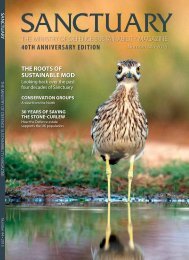SUSTAINABILITY
UBUt5
UBUt5
Create successful ePaper yourself
Turn your PDF publications into a flip-book with our unique Google optimized e-Paper software.
FEATURES<br />
Forty years on Salisbury Plain, how the<br />
battle to save archaeology was won<br />
At a basic level the commandant was faced with large<br />
areas that needed rest and repair, but the broader debate<br />
concerned the future - what could be done to prevent a<br />
repeat of this threat to both heritage and training?<br />
In the mid 1970s, a start was made<br />
on compiling the Wiltshire Sites and<br />
Monuments Record (SMR). Salisbury<br />
Plain was a special problem, renowned<br />
for its heritage but diffcult to access.<br />
By 1981 the SMR was complete, but still<br />
lacking detail for the Plain. Reports from<br />
conservation groups indicated damage<br />
to sites, and as County Archaeologist,<br />
I gathered more information by<br />
attending group meetings.<br />
By 1982, the press took an interest,<br />
particularly in relation to the Romano-<br />
British settlement at Chisenbury<br />
Warren. This unprotected site was<br />
highly vulnerable to units hiding in<br />
the warren then dashing forward<br />
to ambush opposition forces. The<br />
headline ‘tanks train on Roman village’<br />
focused the collective mind, resulting<br />
in a dialogue between MOD, English<br />
Heritage and Wiltshire Council.<br />
What emerged was intriguing. First, no<br />
true record of archaeology on the Plain<br />
existed. Second, although some sites<br />
were Scheduled Ancient Monuments<br />
(SAMs), many of the most outstanding<br />
features were not Scheduled. Third, the<br />
army had not been provided with a<br />
list of SAMs or guidance on protecting<br />
sites. MOD threw down the gauntlet<br />
- if archaeologists would define what<br />
was important it would do its best to<br />
implement safeguards.<br />
The result was a massive survey in<br />
1985, funded by English Heritage and<br />
subsequently by MOD. The resultant<br />
database and mapping recorded<br />
over 2200 sites, including around 600<br />
prehistoric burial mounds. A bold<br />
decision to schedule over 500 sites<br />
was made.<br />
The next step was to agree on<br />
measures of protection. MOD had<br />
for decades marked some sites with<br />
metal star-signs, and an extension<br />
of this technique which involved<br />
placing a ring of signs around the<br />
monument rather than a single star<br />
at its centre, proved valuable. The<br />
Surface damage caused by vehicle movement in wet conditions. © Wiltshire Council<br />
real challenge was to protect clusters<br />
of earthworks covering substantial<br />
areas. These could include landscapes<br />
with many components and the term<br />
Archeological Site Group (ASG) was<br />
coined. A core consideration was to<br />
ensure that military training was not<br />
unduly inhibited, so management<br />
measures sought to guide units<br />
through these zones rather than<br />
impose exclusion. One group of<br />
archaeological earthworks was<br />
elevated to top status, labelled as<br />
Important and Fragile Sites (IFSs).<br />
They numbered seven and included<br />
some of the best preserved and rarest<br />
features found in the country. Only<br />
training on foot was permitted within<br />
them, and they are marked on the<br />
training area map as no-go areas.<br />
These measures were introduced in<br />
the period 1986-1993, a challenge<br />
particularly for the commandant<br />
to appreciate the requirement and<br />
agree suggested measures. These<br />
might include not only signage but<br />
new tracks, closing old tracks, new<br />
fenced enclosures, plantations to<br />
block movement, part clearance of<br />
plantations to permit movement,<br />
whatever was needed to fulfill the<br />
management plans. It was in this<br />
period that English Nature (now<br />
Natural England) registered a vast<br />
zone with the status of Site of Special<br />
Scientific Interest (SSSI). Henceforth,<br />
management plans needed to<br />
accommodate nature conser vation.<br />
The combination of extreme wet<br />
weather and a huge exercise in<br />
the winter of 1993-4 threatened<br />
to destroy much that had been<br />
protected and the good working<br />
relations that had evolved. Huge<br />
areas of grassland had been reduced<br />
to mud; tracks degrading to a point<br />
that even armoured vehicles avoided<br />
them, cutting fresh routes alongside<br />
and generate a sea of devastation,<br />
26<br />
Sanctuary 44 • 2015



